For James Boswell, Wednesday 19th January, 1763, was a day eagerly anticipated: together with two other young Scots gentlemen friends, he was intent on a grand traverse of London, a city that excited him almost to fever-pitch, and to which he’d fled the previous year, seeking a way into literary-theatrical circles and the beau monde, while fleeing the strictures of his Calvinistic family.
Rendezvousing at ‘Hide-park corner’ at ten in the morning, trio’s ‘spirits were high with the notion of Adventure, and the variety that we met with as we went along is amazing […] one end of London is like a different country from the other in look & manners.’ All this within a six-mile promenade that included breakfast at a coffee house on the Strand, and a diversion to witness from the medieval London Bridge the sublime sight of ‘the river froze up, partly covered with enormous shoals of floating ice which often crash’d against one another.’
Boswell’s traverse of this country-within-a-city ended at an elegant row of only recently built houses on the Whitechapel Road – some of which remain to this day. Just shy of a 140 years later, in the summer of 1902, the American writer Jack London, the author of ‘Call of the Wild’ and much else, arrived in the city with a view to investigate the mores of the same general area: the East End of London, which by then had indeed become a sort of foreign country to those not actually resident there.
London’s acquaintances do their best to put him off, saying they have never been to this godforsaken region – so he goes to Thomas Cook & Co to arrange his perilous adventure. But while they will happily send him to ‘Darkest Africa’ or ‘innermost Thibet’, this faraway nearby is beyond their competence: ‘“Consult the police,” [the travel agent] concluded authoritatively, when I had persisted. “We are not accustomed to taking travellers to the East End; we receive no call to take them there, and we know nothing whatsoever about the place at all.”’
Just over 120 years later, this sense of the metropolis as being not just a country-within-a-country, but a world entire, has reached fruition. Boswell’s London was pretty much monoglot – London’s London had a substantial Yiddish-speaking enclave around Whitechapel, but was otherwise divided mostly by class rather than culture or ethnicity. Even the London of my childhood in the 1960s, while claiming to be cosmopolitan, only boasted a first andsecond-ge neration population of around 4%. But 2023 London is a true ‘world city’, with substantial immigrant communities from scores of different countries: a third of Londoners were born elsewhere than Britain, while anything up to half the city’s population has arrived since the millennium.
Some have heralded the abatement of the pandemic as a cue to resume their restless world-girdling in search of life-spicing variety, but by reason of both proclivities and necessities I shan’t bore you with, I find myself confined to
the capital for this rest of this year – much the way that those fallen idols of Boswell’s hame-land, Sturgeon & Murrell, find themselves confined to the lowlands due to the sequestration of their motorhome.
So, I’ve decided to take up the challenge that this babel of boroughs represents, and over the next few months I intend to visit the most diverse regions of the capital (if this can be quantified), from the Somali and Bengali heritage communities of Tower Hamlets, to the Pakistani one of Redbridge and the Indian one centred on Southall. Not forgetting the Polish community still going strong in Ealing – or the African-Caribbean ones centred on Croydon and where I live in Lambeth. What about the Japanese in Finchley and the Jews in Stoke Newington? Rest assured – I shall not neglect them, anymore that I will the weird agglomération of French bankers and their families around Clapham, or the Nigerians of Peckham and Thamesmead.
I’ve used this modest bully-pulpit of mine in the past to excoriate those who substitute air miles for engagement, and while I by no means regard myself as a laggard when it comes to legging it through London, the fact remains that there’s a hell of a lot more to learn. So, watch this space in the coming months for despatches from a different kind of foreign correspondent. In an era when that hardy prejudicial perennial, bigotry, has become the stock-in-trade of the jobbing political class, let my journeying to the several heartlands of London act as a modest corrective.



